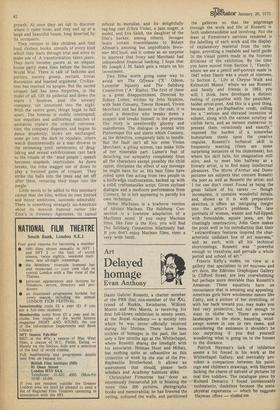Art
Delayed homage
Evan Anthony
Dante Gabriel Rossetti, a charter member of the PRB (but non-member of the ItA), friend of Ruskin, Swinburne, William Morris and Mrs Morris, is receiving his first full-blown exhibition in ninety years, at the Royal Academy — a society into which he was never officially received during his lifetime. There have been trickles of homages in the past, the last only a few months ago at the Whitechapel, where Rossetti shared the limelight with his associates, Holman Hunt and Millais, but nothing quite so exhaustive as this collection of work by the star of the PreRaphaelite Brotherhood. It allows an assessment that should please both scholars and Academy habitués alike.
Christopher Firmstone has ' done an enormously resourceful job in housing the more than 300 pictures, photographs, books and memorabilia; he has lowered the ceiling, coloured the walls, and partitioned the galleries so that the pilgrimage through the work and life of Rossetti is both understandable and involving. Not the least of Firmstone's services rendered is the labelling of each work and the display of explanatory material from the catalogue, providing a readable and lucid guide to the visual points made in the fourteen divisions of the exhibition. By the time you have moved from Section 1, 'Family,' where we see a pencil self-portrait made in 1847 when Dante was a youth of nineteen, to Section 2, 'Life at Cheyne Walk and Kelmscott Manor,' where we see Rossetti and family and friends in 1863, you will, I think, have developed a distinct feeling of sympathie with the paunchier, balder artist-poet. And this is a good thing, because the pre-Raphaelite credo, calling for a "serious and elevated invention of subject, along with the earnest scrutiny of visible facts, and an earnest endeavour to present them veraciously and exactly," imposed the burden of a somewhat humourless thesis upon the creative impulse. Rossetti's technical skill is frequently wanting (there are some surprising instances of his clumsiness), but where his skill fails, his imagination still stirs; and to meet him halfway as a literary artist, is to find many intellectual pleasures. The Morte d'Arthur and Dante pictures are subjects that concern Rossetti the poet as well as Rossetti the artist; and I for one don't count Found as being the great failure of his career — though incomplete, it contains wonderful details, and, shown as it is with preparation sketches, it offers an intriguing insight into the artist's problems. The late portraits of women, waxen and full-lipped, with formidable, square jaws, are fascinatingly unattractive; John Gere makes the point well in his introduction that their " extraordinary features inspired the characteristic undulant line of art nouveau," and as such, with all his technical shortcomings, Rossetti was "powerful enough to transform and pervade a whole period and school of art."
Francis Kelly's nudes, on view at a gallery that specialises in art nouveau and art deco, the Editions Graphiques Gallery in Clifford Street, are less overwhelming but perhaps more desirable than Rossetti's Amazons. These aquatints have an insouciance that is amusing and appealing.
American girls have wholesome names like Cathy, and a picture of her stretching, or with her back toward you, may make you feel very protective, but not enough to want to clothe her. There are several landscapes in the show, haunting, wind swept scenes in one or two cases, and considering the ambience it shouldn't be too surprising if you find yourself wondering what is going on in the houses in the distance.
Patrick Hayman's lack of inhibition seems a bit forced in his work at the Whitechapel Gallery, and inevitably pro vokes a comparison between his paintings and children's drawings, with Hayman lacking the charm of naiveté of pictures by real live toddlers. The catalogue piece by • Richard Demarco I found unreasonably enthusiastic, doubtless because the meta physical experience — which 'he suggests Hayman offers — eluded me.


































 Previous page
Previous page